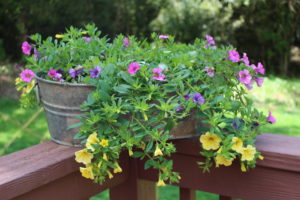Container Gardening
go.ncsu.edu/readext?679118
en Español / em Português
El inglés es el idioma de control de esta página. En la medida en que haya algún conflicto entre la traducción al inglés y la traducción, el inglés prevalece.
Al hacer clic en el enlace de traducción se activa un servicio de traducción gratuito para convertir la página al español. Al igual que con cualquier traducción por Internet, la conversión no es sensible al contexto y puede que no traduzca el texto en su significado original. NC State Extension no garantiza la exactitud del texto traducido. Por favor, tenga en cuenta que algunas aplicaciones y/o servicios pueden no funcionar como se espera cuando se traducen.
Português
Inglês é o idioma de controle desta página. Na medida que haja algum conflito entre o texto original em Inglês e a tradução, o Inglês prevalece.
Ao clicar no link de tradução, um serviço gratuito de tradução será ativado para converter a página para o Português. Como em qualquer tradução pela internet, a conversão não é sensivel ao contexto e pode não ocorrer a tradução para o significado orginal. O serviço de Extensão da Carolina do Norte (NC State Extension) não garante a exatidão do texto traduzido. Por favor, observe que algumas funções ou serviços podem não funcionar como esperado após a tradução.
English
English is the controlling language of this page. To the extent there is any conflict between the English text and the translation, English controls.
Clicking on the translation link activates a free translation service to convert the page to Spanish. As with any Internet translation, the conversion is not context-sensitive and may not translate the text to its original meaning. NC State Extension does not guarantee the accuracy of the translated text. Please note that some applications and/or services may not function as expected when translated.
Collapse ▲Container gardening is a great option for many gardeners. Gardening in containers offers a lot of flexibility. You can grow plants inside your house, in a small area, or move plants around your yard. Here are some tips for container gardening:
- Choose a container that has drainage holes in the bottom. If you overwater, this will allow water to drain out the bottom.
- If you set your container on a saucer, be sure to empty excess water out of that saucer within 30 minutes to an hour after you water. Most plants do not thrive when their roots are submerged in water.
- Fill your container completely with potting soil. You do not want to use soil from your garden; instead choose a potting mix as it is designed to drain properly when used in containers. If you want to try making your own potting soil, see the resources below for more information on what materials to include.
- Do not add any gravel or other material at the bottom of the container. Although it may seem like this would improve drainage, water will build up in the soil above this coarse material and will not drain until the soil is overly saturated.
- Be sure your container gets watered regularly. Most plants will grow well if they are allowed to dry out between waterings, but you don’t want them to get too dry. If you stick your finger about 1 inch into the soil and it is dry, this is a sign that it is time to water. If the soil is still wet at that depth, you can wait to water until later.
- Select the right plants for your container. You may choose to combine several plants for a mixed container, or grow a single plant in a container. Make sure the container gets the correct amount of sunlight for the plant. See the resources for more guidance.
- View our container gardening basics video for a quick overview on how to get started.

Want to know more? Here are some good resouces:




